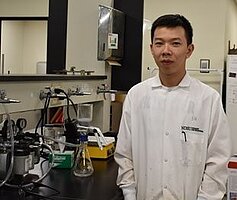Glutaraldehyde Removal from Flowback and Produced Waters Using Photolysis

Soklida Hong is a Master of Science student in Environmental and Conservation Sciences program at North Dakota State University. He holds a Bachelor of Science in Agricultural Science from Royal University of Agriculture, Phnom Penh, Cambodia. His M.S. thesis research is focused on photolysis of glutaraldehyde in flowback and produced waters generated from unconventional oil production.
Email: soklida.hong@ndsu.edu
Phone: 832-646-8686
Fellow: Soklida Hong
Advisor: Advisor: Eakalak Khan, Ph.D., P.E., Professor, Department of Civil and Environmental Engineering, North Dakota State University.
Co-Advisor: Sivaguru Jayaraman, Ph.D., James A. Meier Professor, Department of Chemistry and Biochemistry, North Dakota State University.
Degree Progress: M.S. in Environmental and Conservation Sciences Program, expected graduation in fall 2016.
Glutaraldehyde Removal from Flowback and Produced Waters Using Photolysis
In unconventional oil and gas extraction, hydraulic fracturing has been applied to ensure high and prolonged production of oil and gas from shale deposits. This technology induces cracking network in low-permeability shale to allow trapped oil and/or gas flow to the production wells by injection of hydraulic fracturing fluid at extremely high pressure and flow rate. Primarily, due to this recently improved technique, North Dakota right now is the second largest crude oil producing state in the United States, with 314 million barrels of oil produced in 2013. After hydraulic fracturing, there are two types of waters discharged from the well along with oil and gas. These waters are flowback water, mostly hydraulic fracturing water, and produced water, naturally occurred shale water. Hydraulic fracturing fluid is mainly water (98-99%) and proppant (mostly sand, 1-1.9%); however, several chemicals are added to the water to increase hydraulic fracturing performance. Among the chemical additives, biocides are one of the most common additives in hydraulic fracturing fluid. After hydraulic fracturing, biocides are also periodically injected to the wellbores. They are used to prevent corrosion to the wells associated with microbial growth. Glutaraldehyde (GA) is the most common biocide used in shale fracturing accounting for 80% of all shale fracturing. It is a harmful chemical to environment, human and aquatic organisms, however, a portion of glutaraldehyde returns with flowback and produced waters making the waters more harmful to the environment. This study will investigate the capability of photolysis by UV light in removing glutaraldehyde in flowback and produced waters, since this technology has small footprints, easy to operate, and effective against organic compounds.
Project Objectives:
- Determine GA removal efficiency and kinetics by photodegradtion;
- Elucidate removal mechanism, pathways, intermediates, by-products, and end-products of GA photodegradation and their biodegradability; and
- Identify optimal operating conditions for photodegradation of GA.
Progress:
The study is almost completed. All photoreactions have been completed and collected data associated with the study has been analyzed, and interpreted. Photodegradation mechanism and pathways will be proposed accordingly. A full journal manuscript based on the study is being drafted.
Significance:
This project will help to address an obstacle associated with flowback and produced waters treatment and disposal. After removing glutaraldehyde from flowback and produced waters, biological treatment, which is economical, will become viable for treatment of the waters, or makes the waters less harmful for disposal. The project will deliver a cost effective treatment scheme for the reuse and disposal of the flowback and produced waters which in turn will benefit the oil and gas production industry in cost saving on fracturing water and the environment in minimizing pollutants discharge. Additionally, water withdrawal from natural reservoirs for hydraulic fracturing process will be alleviated if flowback and produced waters can be recycled. Furthermore, the project will establish for the first time an optimal method to detect and quantify the actual concentration of glutaraldehyde in flowback and produced waters which is important to accurately evaluate the impact of flowback and produced waters to the environment.

Eakalak Khan
Civil and Environmental Engineering

Sivaguru Jayaraman
Chemistry and Bichemistry
Office: Ladd 104H
Telephone:701-231-8831
Email: Sivaguru.Jayaraman@ ndsu.edu


